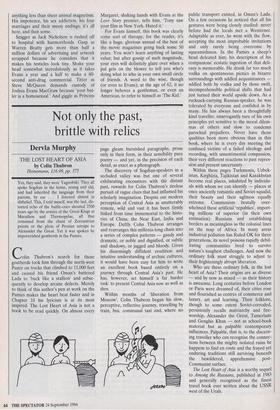Not only the past, brittle with relics
Dervla Murphy
THE LOST HEART OF ASIA by Colin Thubron Heinemann, £16.99, pp. 375
Yes, they said, they were Yagnobski. They all spoke Sogdian in the home, young and old, and had inherited the language from their parents, by ear ... I listened almost in disbelief. This, I told myself, was the last, dis- torted echo of the battle-cries shouted 2500 years ago by the armies of the Great Kings at Marathon and Thermopylae, all that remained from the chant of Zoroastrian priests or the pleas of Persian satraps to Alexander the Great. Yet it was spoken by impoverished goatherds in the Pamirs.
Colin Thubron's search for those goatherds took him through the north-west Pamir on tracks that climbed to 11,000 feet and caused his friend Oman's battered Lada to 'buck like a stallion' and subse- quently to develop arcane defects, Merely to think of this author's pen at work on the Pamirs makes the heart beat faster and in Chapter 10 his lyricism is at its most inspired. The Lost Heart of Asia is not a book to be read quickly. On almost every page gleam burnished paragraphs, prose only in their form, in their sensibility pure poetry — and yet, in the precision of each detail, as exact as a photograph.
The discovery of Sogdian-speakers in a secluded valley was but one of several exhilarating encounters with the distant past, rewards for Colin Thubron's tireless pursuit of vague clues that had inflamed his scholarly imagination. Despite our modern perception of Central Asia as unutterably remote, wild and vast it has been firmly linked from time immemorial to the histo- ries of China, the Near East, India and Europe. Deftly Colin Thubron arranges and rearranges this millenia-long chain into a series of complex patterns — gaudy and dramatic, or noble and dignified, or subtle and shadowy, or jagged and bloody. Given his disarmingly diffident erudition and intuitive understanding of archaic cultures, it would have been easy for him to write an excellent book based entirely on a journey through Central Asia's past. He has, however, set himself a far harder task: to present Central Asia now as well as then.
Within months of 'liberation from Moscow', Colin Thubron began his slow, perceptive, reflective journey, travelling by train, bus, communal taxi and, where no public transport existed, in Oman's Lada. On a few occasions he noticed that all his gestures were being closely studied: never before had the locals met a Westerner. Adaptable as ever, he went with the flow, accepting the most improbable invitations and only rarely being overcome by squeamishness. In the Pamirs a sheep's head defeated him; his description of his companions' ecstatic ingestion of that deli- cacy is memorable. He drank far too much vodka on spontaneous picnics in bizarre surroundings with addled acquaintances — addled both by vodka and by those swift, incomprehensible political shifts that had just turned their world upside down. As a rucksack-carrying Russian-speaker, he was tolerated by everyone and confided in by many. He has always been a thoughtfully kind traveller, unarrogantly sure of his own principles yet sensitive to the moral dilem- mas of others and slow to condemn parochial prejudices. Never have those qualities been more obvious than in this book, where he is every day meeting the confused victims of a failed ideology and recording, with unsentimental compassion, their very different reactions to past repres- sion and present uncertainty.
Within these pages Turkmenia, Uzbek- istan, Kirghizia, Tajikistan and Kazakhstan become real places, inhabited by individu- als with whom we can identify — places at once anciently romantic and Soviet-squalid, their beauty and their ugliness equally extreme. Communism brutally over- whelmed these artificial 'republics', import- ing millions of superior (in their own estimation) Russians and establishing borders as meaningless as the colonial lines on the map of Africa. In many areas industrial pollution has Ruled OK for three generations, its novel poisons rapidly debil- itating communities bred to survive nature's toughest challenges. And now the ordinary folk must struggle to adjust to their frighteningly abrupt liberation.
Who are these ordinary folk, in the lost heart of Asia? Their origins are as diverse — and by now as mixed — as their history is awesome. Long centuries before London or Paris were dreamed of, their cities rose and flourished as centres of commerce and luxury, art and learning. Their folklore, though to some extent Soviet-corroded, persistently recalls matriarchy and fire- worship, Alexander the Great, Tamerlane and Genghis Khan — not as school-book material but as palpable contemporary influences. Palpable, that is, to the discern- ing traveller who can recognise the connec- tions between the mighty isolated ruins he happens to find en route and the frayed yet enduring traditions still surviving beneath the bewildered, apprehensive post- Communist surface.
The Lost Heart of Asia is a worthy sequel to Among the Russians, published in 1983 and generally recognised as the finest travel book ever written about the USSR west of the Urals.


































































 Previous page
Previous page